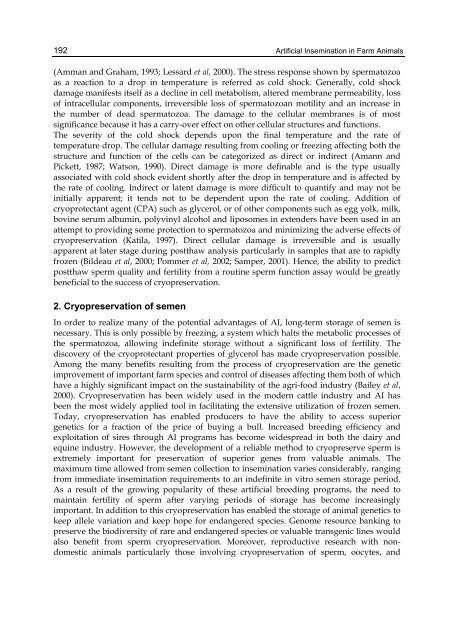ARTIFICIAL INSEMINATION IN FARM ANIMALS - Phenix-Vet
ARTIFICIAL INSEMINATION IN FARM ANIMALS - Phenix-Vet
ARTIFICIAL INSEMINATION IN FARM ANIMALS - Phenix-Vet
Create successful ePaper yourself
Turn your PDF publications into a flip-book with our unique Google optimized e-Paper software.
192Artificial Insemination in Farm Animals(Amman and Graham, 1993; Lessard et al, 2000). The stress response shown by spermatozoaas a reaction to a drop in temperature is referred as cold shock. Generally, cold shockdamage manifests itself as a decline in cell metabolism, altered membrane permeability, lossof intracellular components, irreversible loss of spermatozoan motility and an increase inthe number of dead spermatozoa. The damage to the cellular membranes is of mostsignificance because it has a carry-over effect on other cellular structures and functions.The severity of the cold shock depends upon the final temperature and the rate oftemperature drop. The cellular damage resulting from cooling or freezing affecting both thestructure and function of the cells can be categorized as direct or indirect (Amann andPickett, 1987; Watson, 1990). Direct damage is more definable and is the type usuallyassociated with cold shock evident shortly after the drop in temperature and is affected bythe rate of cooling. Indirect or latent damage is more difficult to quantify and may not beinitially apparent; it tends not to be dependent upon the rate of cooling. Addition ofcryoprotectant agent (CPA) such as glycerol, or of other components such as egg yolk, milk,bovine serum albumin, polyvinyl alcohol and liposomes in extenders have been used in anattempt to providing some protection to spermatozoa and minimizing the adverse effects ofcryopreservation (Katila, 1997). Direct cellular damage is irreversible and is usuallyapparent at later stage during postthaw analysis particularly in samples that are to rapidlyfrozen (Bildeau et al, 2000; Pommer et al, 2002; Samper, 2001). Hence, the ability to predictpostthaw sperm quality and fertility from a routine sperm function assay would be greatlybeneficial to the success of cryopreservation.2. Cryopreservation of semenIn order to realize many of the potential advantages of AI, long-term storage of semen isnecessary. This is only possible by freezing, a system which halts the metabolic processes ofthe spermatozoa, allowing indefinite storage without a significant loss of fertility. Thediscovery of the cryoprotectant properties of glycerol has made cryopreservation possible.Among the many benefits resulting from the process of cryopreservation are the geneticimprovement of important farm species and control of diseases affecting them both of whichhave a highly significant impact on the sustainability of the agri-food industry (Bailey et al,2000). Cryopreservation has been widely used in the modern cattle industry and AI hasbeen the most widely applied tool in facilitating the extensive utilization of frozen semen.Today, cryopreservation has enabled producers to have the ability to access superiorgenetics for a fraction of the price of buying a bull. Increased breeding efficiency andexploitation of sires through AI programs has become widespread in both the dairy andequine industry. However, the development of a reliable method to cryopreserve sperm isextremely important for preservation of superior genes from valuable animals. Themaximum time allowed from semen collection to insemination varies considerably, rangingfrom immediate insemination requirements to an indefinite in vitro semen storage period.As a result of the growing popularity of these artificial breeding programs, the need tomaintain fertility of sperm after varying periods of storage has become increasinglyimportant. In addition to this cryopreservation has enabled the storage of animal genetics tokeep allele variation and keep hope for endangered species. Genome resource banking topreserve the biodiversity of rare and endangered species or valuable transgenic lines wouldalso benefit from sperm cryopreservation. Moreover, reproductive research with nondomesticanimals particularly those involving cryopreservation of sperm, oocytes, and










